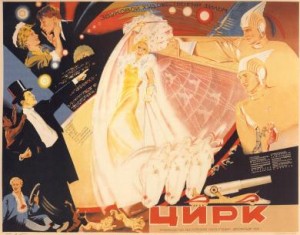The idea of the USSR as a “communal apartment” presents the idea of socialism and the Soviet state in an analogy that is easy to grasp and remember ((Yuri Slezkine, The USSR as a Communal Apartment, or How a Socialist State Promoted Ethnic Particularism) Slavic Review 53 no. 2, (1994), p. 414))). The “communal apartment” ties in with the author’s thesis of the creation within the Soviet Union and the “Bolsheviks efforts on behalf of ethnic particularism.” Consistent efforts is seen in promoting group rights even at the cost of not harmonizing with rights of the proletariat, in contrast showing hostility to the rights of the individual ((Yuri Slezkine, The USSR as a Communal Apartment, or How a Socialist State Promoted Ethnic Particularism) Slavic Review 53 no. 2, (1994), p. 415))). Part of the whole socio-political experiment is summed up in the following quote, “ ‘The world’s first state of workers and peasants’ was the world’s first state to institutionalize ethnoterritorial federalism, classify all citizens according to their biological nationalities and formally prescribe preferential treatment of certain ethically defined populations” ((David A. Hollinger, How Wide the Circle of the ‘We’? American Intellectuals and the Problem of Ethos since World War Two) American Historical Review 98 no. 2, (1993), pp. 317-337))). These nationalities would make up the separate rooms of the Soviet Federation.
This idea at first may seem contrary to socialism. Even early socialist closely tied to Lenin disagreed with this approach. Yet here Stalin and Lenin both agreed on this idea. To be clear we need to differentiate between “national culture” and “national traits, interest and responsibilities”. The USSR’s makeup consists of various groups such as Ukrainians, Russians, and Georgians whom each possessed individual peculiarities that made them such, national traits. Thus, these groups viewed as separate nations, possessed rights ((Yuri Slezkine, The USSR as a Communal Apartment, or How a Socialist State Promoted Ethnic Particularism) Slavic Review 53 no. 2, (1994), p. 416))). Acknowledging that each group had its own unique rights played a key part in unity of the federation. Stalin stated, “Nations are sovereign and all nations are equal” ((Yuri Slezkine, The USSR as a Communal Apartment, or How a Socialist State Promoted Ethnic Particularism) Slavic Review 53 no. 2, (1994), p. 416))). Equality in no way means that all nations are equal in size, power, economy or in their development whether “civilized” or “backward”. “But all nations—indeed all nationalities no matter how “backward”—were equal because they were equally sovereign, that is, because they all had the same rights” ((Yuri Slezkine, The USSR as a Communal Apartment, or How a Socialist State Promoted Ethnic Particularism) Slavic Review 53 no. 2, (1994), p. 416))).
This entire idea seems to be counter-intuitive. It railed against what many socialist viewed as an “‘philistine ideal.’ Lenin’s socialists had to “preach against [slogans of national culture] in all languages, ‘adapting’ themselves to all local and national requirements”” ((Yuri Slezkine, The USSR as a Communal Apartment, or How a Socialist State Promoted Ethnic Particularism) Slavic Review 53 no. 2, (1994), pp. 417-18))). Therein lies the crux of the issue why allow for nations within the federation. It was a necessary evil to get individuals to adopt socialism, someone who was of the same language and background to support and perpetuate socialism. Now the locals view socialism as a nationally owned idea and not as an imposed idea of a different nation. Lenin also came to realize that to gain the trust of these once former oppressed nations under tsarist control, recognition as a nation built confidence and trusts in the idea of the USSR and promoted the idea of acceptance to state socialism. This doctrine actually was successful through the 1930s. Nearly 200 separate national identities emerged with schools, periodicals and communities establish to support this grandiose effort. This required a massive bureaucracy to manage this system, requiring change of policy again.
Finally, “by the end of the decade most ethnically defined soviets, villages, districts and other small units had been disbanded, some autonomous republics forgotten and most “national minority” schools and institutions closed down…however…the ethnic groups that already had their own republics and their own extensive bureaucracies were actually told to redouble their efforts at building distinct national cultures.” The idea behind this was “in order to concentrate on a few full-fledged, fully equipped “nations” ((Yuri Slezkine, The USSR as a Communal Apartment, or How a Socialist State Promoted Ethnic Particularism) Slavic Review 53 no. 2, (1994), p. 445))). The purpose behind this idea was to promote culture to the various republics through the arts, which lasted until the demise of the USSR in an attempt to bring a cohesiveness to the state. Emphasis now is on a national language in addition to the language of each individual’s nationality to reaffirm this solidarity of state. Did this experiment work? The answer is summed up in the final word of the article where it states, “Seventy years after the X Party Congress the policy of indigenization reached its logical conclusion: the tenants of various rooms barricaded their doors and started using the windows, while the befuddled residents of the enormous hall and kitchen stood in the center scratching the backs of their heads [referring to the Russians]. Should they try to recover their belongings? Should they knock down the walls? Should they cut off the gas? Should they covert their “living area” into a proper apartment?” ((Yuri Slezkine, The USSR as a Communal Apartment, or How a Socialist State Promoted Ethnic Particularism) Slavic Review 53 no. 2, (1994), pp. 451-2))). So goes the social experiment, the Soviets seemed always to take the most convoluted way to get to a goal, ultimately the tenants final decision to flee the communal apartment passes judgment on this grand experiment.

